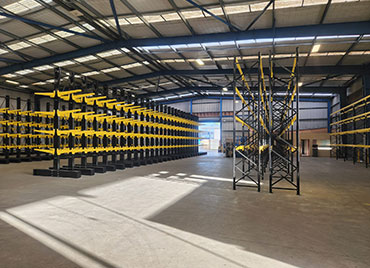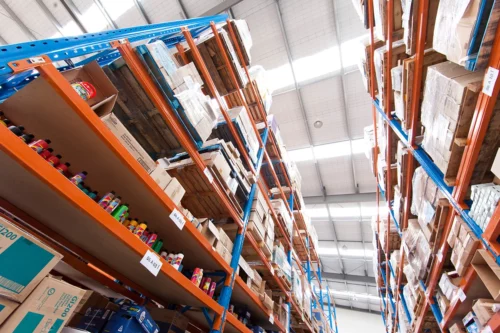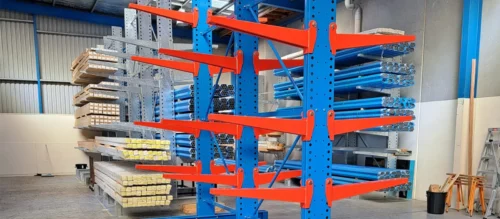Warehouse shelving is a pivotal element in boosting overall warehouse efficiency, offering the potential to maximize storage capacity and streamline operations.
The choice of the right shelving system plays a critical role in determining workflow, organisation, and the overall effectiveness of a warehouse.
In this comprehensive guide, we delve into the impact of warehouse storage and shelving on efficiency, explore various types of shelving systems, and provide essential tips for selecting the most suitable option for specific business needs.
Understanding the Impact of Warehouse Shelving on Efficiency
The selection of warehouse shelving and storage systems directly influences various facets of warehouse operations, including workflow, organisation, safety and overall efficiency. A strategically chosen shelving and storage system aligns with the size and type of inventory, leading to improved workflow.

Whether it’s heavy-duty pallet and warehouse racking systems for bulk storage or commercial shelving for versatile applications, the organisation of goods plays a vital role in speeding up the process of locating and retrieving items, consequently enhancing workflow efficiency.
This impact extends to critical operational areas such as order fulfilment, inventory management, and space utilisation. An efficiently planned shelving system facilitates swift order fulfilment by allowing quick access to stored items, leading to faster dispatch times and improved customer satisfaction.
An effective warehouse shelving system allows businesses to make the most of available space, optimising vertical storage and horizontal rows of shelves, ensuring no square meterage is wasted while industrial shelves ensure safety.
Types of Warehouse Shelving
Heavy Duty Shelving
Ideal for warehouses storing large and heavy items, heavy-duty shelving provides a robust solution with high load-bearing capacities. Constructed from durable materials like steel, these industrial steel shelving and systems ensure safe and secure storage of heavy goods.

Adjustable shelves enhance accessibility, and the inherent strength of these shelving units enables vertical stacking, maximising vertical space for inventory and increasing overall storage density. The durability and robustness of heavy-duty shelving reduce the risk of damage to goods, contributing significantly to warehouse efficiency.
Commercial Shelving
Commercial shelving stands out as a versatile storage solution suitable for a wide variety of items. Characterised by adaptability, these systems are typically adjustable, allowing for easy modification to accommodate different types and sizes of goods.
The flexibility of commercial shelving enhances space utilisation and ensures easy access to stored items, streamlining the picking and dispatch process. With the capability to withstand significant weight loads, these shelving systems provide a safe and sturdy storage solution, contributing to enhanced operational productivity and increased storage capacity.
Cantilever Racking
Cantilever racking offers a versatile and efficient storage solution, particularly for warehouses storing long, bulky, or irregularly shaped items. The unique design of racking, featuring arms extending from a single vertical column, allows unobstructed storage of items such as timber, piping, or furniture.

This design maximizes space utilisation by enabling horizontal storage across the entire length of the arms, optimising storage density. The absence of a front column provides easy, direct access to stored items, significantly enhancing the speed and efficiency of the picking process.
Cantilever racking contributes significantly to warehouse efficiency by ensuring optimised space utilisation, easy accessibility of goods, and adaptable storage solutions. Cantilever racking are also famous for high-density storage and its quality, click here to learn more about our Cantilever Racking systems.
Tips for Choosing the Right Warehouse Shelving
-
Assessing Warehouse Needs:
The first step in choosing the right shelving system is a thorough assessment of the specific needs of the warehouse. Key guidelines include:
Understanding Your Product: Consider the size, weight, and shape of products to determine the type of industrial shelving needed to suit your needs. Another factor to consider is the material, steel shelving systems are the industry standard as they are more resistant than other materials.
Considering the Volume of Goods: Assess the quantity of goods to be stored and choose a shelving or storage system, that aligns with the volume of goods stored there, whether it’s a high-volume shelving system or commercial shelving for smaller volumes.
Evaluating Your Workflow: Understand the flow of goods within the warehouse space, considering the frequency and volume of pick-ups and deliveries to determine the required accessibility from the shelving system.
Factoring in Future Growth: Plan for growth by choosing a shelving system that can be easily expanded or modified to accommodate future increases in product range or volume.
Prioritising Safety: Ensure that the selected shelving system conforms to safety regulations and considers the specific safety requirements of products and employees.
Armed with this knowledge, businesses can select a warehouse shelving system that aligns with their needs, enhances efficiency, and contributes to the overall success of warehouse operations.
-
Budget Considerations:
While budget constraints are undeniably important, striking the right balance between cost and operational efficiency is crucial when selecting the best warehouse shelving and racking system. Considerations include:
Total Cost of Ownership (TCO): Go beyond the initial purchase price and consider the overall TCO, including installation, maintenance, repairs, and potential replacements. A shelving system with a lower TCO may offer better value over the other long term storage amount.
Assessing Durability: Consider the quality and durability of all the pallets and shelving systems. While durable shelving may be more expensive upfront, it can save money in the long run by reducing the frequency and cost of repairs or replacements.
Considering Modular Systems: Explore modular shelving systems that can be expanded or contracted as needed, providing flexibility and making it easier to adapt to changes in storage space needs without significant additional cost.
By carefully considering these factors, businesses can choose storage systems that offers the best balance between cost and functionality, maximising efficiency while staying within budget.
Conclusion
In conclusion, the selection of a warehouse shelving system and pallet racking is a strategic decision with profound implications for warehouse efficiency and operational cost-effectiveness. Different types of shelving and pallet racks, including heavy-duty, commercial, cantilever, and mobile systems, offer unique advantages tailored to specific needs.
Many warehouses are successful in this difficult task installing shelves with multiple levels in its storage area to handle pallets, boxes and other goods to ensure better visibility of the labels and achieving the maximum efficiency when dispatching products.
Understanding the requirements as they are different for the types of warehouse, factoring in safety considerations, and considering budget constraints ensure a wise investment in shelving of racking system. The right shelving and pallet racking system enhances storage capacity, improves accessibility, and streamlines operations, ultimately contributing to increased overall warehouse productivity.
